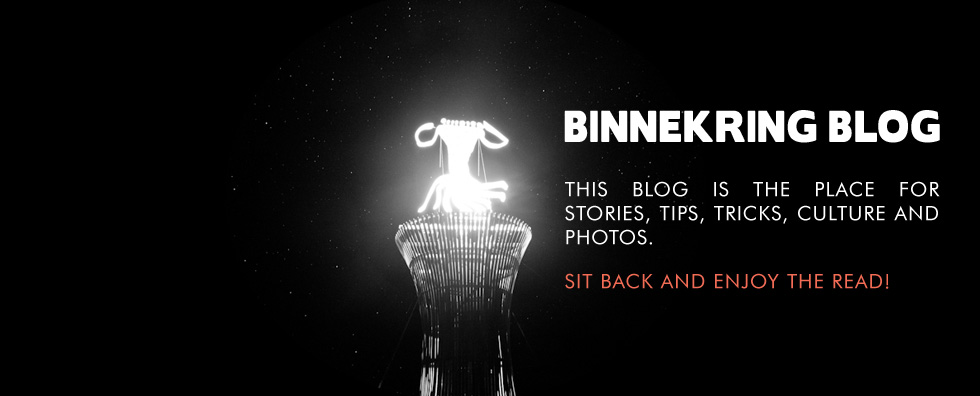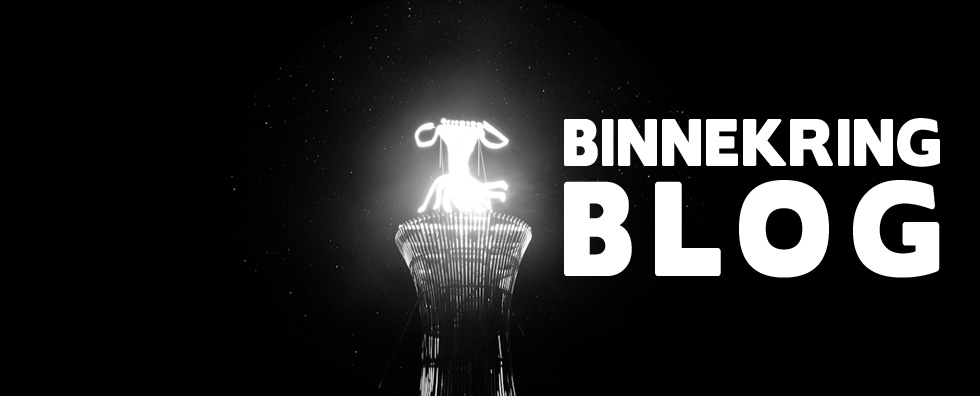BINNEKRING BLOG
The fire, the ceremonial firemaster, the fireman and the burner at AfrikaBurn
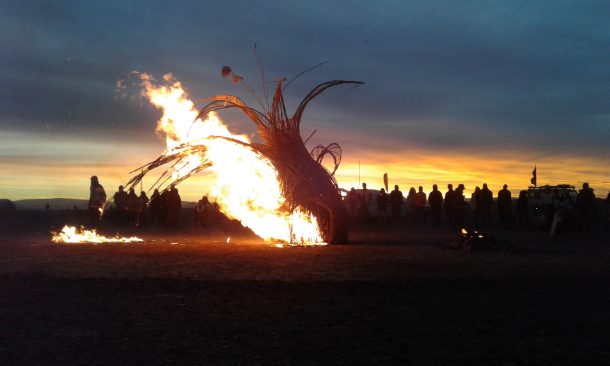
(Featured image of fireman Rob Erasmus far left and Skeleton Leaf of Change art work burn by John Steele, other images as per credit, text by Eleen Polson unless otherwise quoted.)
The big thing about AfrikaBurn, that makes it something different to a music festival, or a consciousness festival, is the creation and burning of Art, and specifically the burning of the big artwork that represent the community, the Clan (the equivalent of which is called ‘The Man’ at Burning Man in Black Rock City, Nevada). I so love that our African version is collective and tribal, reflecting our ubuntu spirit as a Clan, an ephemeral tribe gathered from across the globe for this time together.
The Binnekring is a play park for adults, a reclaiming of our joy to interact with the elements, to create, enjoy and destroy. We used to create sand pits full of worlds and enjoyed trampling it underfoot when called for lunch… We loved to build little fires and cook our own food on it. We have all played with fire and dreamt of either being a fireman – or being rescued by one. Fire is part of our deepest human psyche, the grappling with our relationship with the basic elements and our power (our ability to manifest change) in relation to them. We play with finding the balance between danger and control; stability and change. Here, on the Binnekring with this tribe, we can again create with boldness, just for the joy of it, and see it go up in smoke. We collectively practice our ability to let go of ‘this’ so that we can have more of ‘that’. We stand in awe of the power of the wind, the dust, and the fire, gasping when warm clouds of embers make their presence felt. “The stars are alive!” one burner rejoiced.
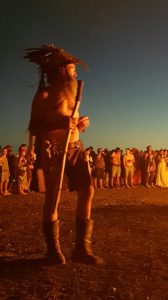 What AfrikaBurn also birthed uniquely into the world, is the role of the ceremonial Firemaster. This position was spontaneously created and stepped into by Martin Glinister – an Afrikaanse boytjie from Limpopo nogals. He is a man of stature and seeing him in his ceremonial regalia the first time took my breath away and transported me to cellular memories of the clan living thousands of years ago. The organisers saw its unique role from the first burn he attended and called him our “Ceremonial Fire Master”, welcoming him into the circle, letting him do what he does. When Martin was only a 5-year-old boy in the northern mountains, playing with his herding buddies in Leboakgomo, he made friends with fire in what could have been a very terrifying incident. It started out as a war between him and a fierce daddy long legs – he won with some matches and toilet paper, but the thatched rondavel he found himself trapped in, was almost the end of them both. During this experience, he was never afraid of the fire but felt calm and protected. It laid the foundation for his respect for fire and all the natural elements, leading him to a life of ceremony and healing in community living (now in the Eden of the Garden route where he still cooks his food every day on fire).
What AfrikaBurn also birthed uniquely into the world, is the role of the ceremonial Firemaster. This position was spontaneously created and stepped into by Martin Glinister – an Afrikaanse boytjie from Limpopo nogals. He is a man of stature and seeing him in his ceremonial regalia the first time took my breath away and transported me to cellular memories of the clan living thousands of years ago. The organisers saw its unique role from the first burn he attended and called him our “Ceremonial Fire Master”, welcoming him into the circle, letting him do what he does. When Martin was only a 5-year-old boy in the northern mountains, playing with his herding buddies in Leboakgomo, he made friends with fire in what could have been a very terrifying incident. It started out as a war between him and a fierce daddy long legs – he won with some matches and toilet paper, but the thatched rondavel he found himself trapped in, was almost the end of them both. During this experience, he was never afraid of the fire but felt calm and protected. It laid the foundation for his respect for fire and all the natural elements, leading him to a life of ceremony and healing in community living (now in the Eden of the Garden route where he still cooks his food every day on fire).
Today when he steps into the fire perimeter, his impressive headgear representing the Phoenix – a mythical creature burning to ashes and rising in glory to a new life – he resembles an ancient link between man and fire, like a shaman dancing an age-old ritual, bringing our dreams, fears, regrets and wishes to be tested, cleansed and blessed. He mindfully links us to the earth and sky with an attitude of forgiveness and gratitude, interceding with a prayer for this year on his lips:
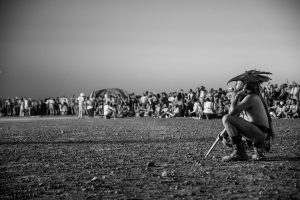
“Oh, that you would bless us and enlarge our territory!
Let your hand be with us, and keep us from harm so that we will be free from pain.”
For days before the big burn, clan members were dancing their bodies into frenzies of ecstasy and abandon, shaking up the past years’ troubles and heartaches away, stomping out the stress and the chaos of normal life to beats of desert rhythms. By the time they gather around the clan burn, they are tired but happy, excited but content. Pooling their energy around them like soft jackets of faux fur and happy friends, their life-energy is sucked into the fire once lit and with awe-inspiring sighs it is burned into glittering embers into the night sky, swirling and dancing to once again reunite with them as the ashes cool, and marshmallows are toasted with much happiness on what was a splendid work of art. A cleansing process on a collective and personal level that you see reflected in the faces lit up by the fire.
Last year (2018) our beloved Fire Master was not there – taking a break after 11 years of service. And we missed him dearly, celebrating his return. That year the artists and builders of these massive works were not supported by this person’s calm presence, physical support (mental, social, spiritual, psychological), sometimes in the form of bodywork on tired shoulders, a massage, a discussion and reflection on the work done, or just a reminder to take some deep breaths. This burning of art is a collective endeavour that represents much more than we could envision; it is a whole new kind of offering to save humanity’s creative soul.
And then there are the firemen, and we specifically have Fireman Rob at the he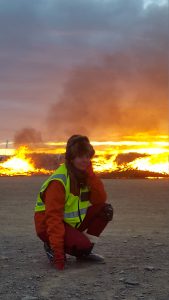 ad of the Fire Safety team. We can always depend on their solid presence and professional support. From Tankwa Town side we provide fire perimeter people: volunteers that help to keep the clan safely away from the fire, until the last piece of wood has fallen, and the fire is safe enough to streak and dance around. This technical expertise is the domain of the Fire Safety team. Over the past 13 years, they have built a strong and trusting relationship with the AfrikaBurn community. As a perimeter volunteer one year I saw the keen observation displayed by the protectors: one indicated that there was a nervous burner, looking edgy and a possible candidate to run into the fire – a rare but unfortunate incident that happened in 2017 in Nevada, and has happened at other Regional events in the past. After making eye contact, and connecting with the jittery person, a sense of calm returned and he sat down to observe the rest of the proceedings. I was deeply reassured that our community is in safe hands with firefighters so aware and focused.
ad of the Fire Safety team. We can always depend on their solid presence and professional support. From Tankwa Town side we provide fire perimeter people: volunteers that help to keep the clan safely away from the fire, until the last piece of wood has fallen, and the fire is safe enough to streak and dance around. This technical expertise is the domain of the Fire Safety team. Over the past 13 years, they have built a strong and trusting relationship with the AfrikaBurn community. As a perimeter volunteer one year I saw the keen observation displayed by the protectors: one indicated that there was a nervous burner, looking edgy and a possible candidate to run into the fire – a rare but unfortunate incident that happened in 2017 in Nevada, and has happened at other Regional events in the past. After making eye contact, and connecting with the jittery person, a sense of calm returned and he sat down to observe the rest of the proceedings. I was deeply reassured that our community is in safe hands with firefighters so aware and focused.
Here is it from our trusted Fireman Rob Erasmus himself:
“Our role at the burn event is primarily to ensure that everyone has a safe and memorable experience. Much of our effort is channelled into fire accident prevention, which includes both the making of campsites safe (removing excess fuels and gas), being on standby for nigh time aircraft medical emergency arrivals and departures, as well as advising artists on ignition positioning and lighting sequences to achieve the maximum effect and impact when burning their art pieces. While having attended to a small number of unwanted fires (gas bottle fires, petrol cans alight, etc.), the majority of reactive tasks are when windblown embers from burning artworks drift and descend over the tented camping areas and it is at such times that the fire teams respond and extinguish firebrands that have the potential to cause large scale runaway fires amongst the occupied areas. While this happens on an annual basis, we are happy to report that while minor damage to tents and stretch covers have occurred, in all cases such embers have been successfully extinguished before they have been able to have started a fire.
In the public eye, the fire team is generally seen moving around the burning artwork from the very start when the ignition takes place until the last standing structural item has fallen. It is crucial that the ignition is successful and it is for this reason that detail is given to the ignition sequence and the progression of the growing fire carefully monitored to ensure that the heavy fuels (the thicker wood structures) catch alight. Once well alight, ongoing attention is given to the burning progress to ensure that all standing structures collapse, and only once this has occurred and all cables and rebar have been removed from around the collapsed burning artwork, can the call to collapse the perimeter be made, allowing the Burners to approach the fire, their distance self-regulated by the heat of the remaining fire.
We are fortunate to enjoy a wonderful relationship with the organisers, artists, Burners, and Ranger component, which goes a long way in contributing to a memorable experience for everyone.”
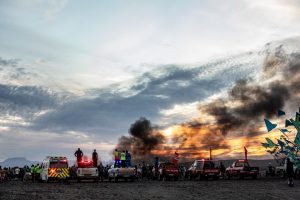
We are indeed fortunate.
ps: here are some more info about the activities our Fire Safety team engage in on a year-round basis:
Assist fire departments with fire fighting : 20 fires
Provide training for farm workers : 25 sessions
Fire investigations : 55 investigations
Fire Safety for outdoor events : 30, including AfrikaBurn
Awareness programmes for kids : 20 x schools
Stack and controlled burning operations : 20 undertakings
Additional projects, such as drone services for fire related matters : 10

